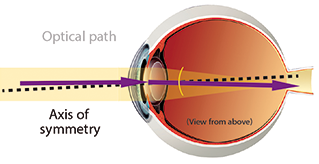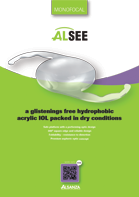Alsee
Alsafree, ALSANZA Hydrophobic Biomaterial:A Glistenings Free New Generation of Hydrophobic Bio-Polymer
A Glistenings Free Hydrophobic Acrylic Material Packed in Dry Conditions
“Glistenings have been observed since the introduction of hydrophobic acrylic IOLs and are frustrating complications for the patient and the surgeon.
These fluid-filled microvacuoles within the IOLs have been reported since the 1990s,”
Our R&D team with its expertize of more than two decades in the IOL industry,
considering the history of the hydrophobic IOL materials with their strengths and weaknesses,
invested considerable time and efforts to come with a bio-polymer Alsafree combining:
- Glistenings-Free
- Designed to minimize PCO
- MICS capable
- Easy handling features
“The glistening phenomenon is related to the hydrophobic acrylic material.
It can allow water to permeate through some of the microscopic channels that are in between the polymer and for some reason,
manipulating the temperature, this allows fluid to go into material. These glistenings are really little microvacules of fluid between the areas of the polymer.”
Glistenings are small fluid-filled pockets that form within the superficial layer of an IOL,
potentially causing a portion of light coming into the eye to be scattered in all directions.
This phenomenon can negatively affect visual acuity.
Prior studies of the visual impact of glistenings have had discordant results,
with one group finding that glistenings significantly decrease contrast sensitivity while another reported such an effect only at high spatial frequencies.
A third group found no significant correlation with contrast sensitivity, but felt that the visual effect could become significant over time as more glistenings develop in the lens.
Alsafree: ALSANZA’s Glistenings Free Hydrophobic Material
Alsafree has a minimum water absorption while in the eye which does not affect the hydrophobic nature of the material Alsafree is in equilibrium with the intraocular environment. There is no aqueous getting in move in and out of the IOL. As a consequence, there is no driving force for water diffusion, thus no haze or glistening.
- Mechanical properties developed for mics: optimized elasticity and high flexibility for a controlled comportment
- Low glass transition temperature (Tg) of -2°C allows an easy handling
- An optimized refractive index (r.i.) of 1.53: thin optic without glare and reflectance as observed in high r.i. IOLs
- The constringence of Alsafree with a high Abbe value (v-number) confirms a low dispersion of light consequently low chromatic abberations.
- Silicon oil adhesion of 15% makes it an excellent material for retinal specialists

ALSANZA IOLs are built on the Liou & Brennan1 (LBE) eye model,
considered to be as the most anatomically accurate eye model in ophthalmology today.
In Liou & Brennan eye model, spherical aberrations are of + 0,27 μm for a pupillary diameter of 6 mm.
The optical model of Liou & Brennan places the young phakic eye in a realistic physiol ogical environment,
taking into account for example the natural decentration of the pupil in nasal and the tilt of the visual axis vs the optical axis.
This aberration correcting asphericity concept provides reproducibility and high refractive outcomes. It provides contrast sensitivity even under low light conditions.
ALSANZA aspheric IOLs respect the natural quantity of spherical aberrations to offer pseudophakic eye visual performance close to the natural phakic eye.
They improve image quality compared to spherical IOLs, they provide high contrast sensitivity for a very large range of spatial frequencies and this,
particularly in difficult visual conditions as low light with a large pupil or in case of slight decentration or tilt of the IOL.
Improved Visual Performance with High MTF Values
Enhanced optic design of ALSANZA IOLs provides superior MTF values and perfect surface topography.
ALSANZA Optics are built on the Modulation Transfer Function (MTF), the optical reference in measuring visual performance and contrast sensitivity.
MTF gives a precise measurement of image degradation, and quantify the way an optic aberration affects the contrast perception for each spatial frequency.
Corrected aberrations on the lens -0.165µm
Average residual aberration on the eye +0.165µm
- Less sensitive to decentration & tilt
- Improve retinal image quality of patients
- Maintain depth of field
- Offer maximum visual performance even in mesopic conditions
ALSANZA IOLs are designed to providerefractive predictability, long term stability and centration.
The 360° Square Edge concept of ALSANZA IOLs creates barrier against PCO or cell migration. Continuous 360° square edges:
a demonstrated efficiency for several decades. Prevention of posterior capsular opacification is an important component
of the global patient satisfaction, even more, when patients are implanted with a premium IOL as a toric or as a multifocal.
All ALSANZA models of IOLs have continuous 360° square edges to delay LEC proliferation and maintain a good quality of vision as long as possible.
Several publications among with Dr Nishi’s1 one, have demonstrated the efficacy of 360° square edges in delaying PCO occurence.
MICS capable, ALSANZA IOLs can be implanted through 1.8 mm incision with our ALSAJET Injection system. ALSANZA IOLs are designed to be used in micro-incision cataract surgery (MICS).
- Astigmatism-neutral cataract surgery
- Higher level of refractive reproducibility
- Reduced risk of endothelial cell loss
- Decreased risk of inflammation
- Contributes to rapid wound healing
- Accelerated post-operative regeneration

